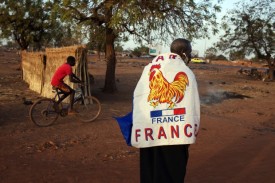Giles Longley-Cook looks at the situation in Mali and French involvement in the region.
Once again a rich Western power is involving itself militarily in the affairs of a third world nation, supplying aid and armed force to the side it deems friendly to its national interests. Time for protests, calls of corruption, anger, condemnation…
Oh wait; it’s not America intervening. OK cancel all that. No, the gung-ho power on this occasion is France. ‘What?’ you ask ‘The country we praised for not bowing to American pressure and invading Iraq with us?’
Yes France, not a country we consider too much militarily these days, has now involved itself, with the UK in close pursuit, in the military conflict in Mali. While not in large numbers, its troops are occupying frontline positions in the battle to eradicate Islamist rebels in the North.
With such similarities to the US interventions in Iraq and Afghanistan (the fight against Islamism, defence of dodgy allies, technological advantages and history of interference with the countries involved) it’s hard to see why one should be accepted as a necessary intervention while the others continue to attract revulsion as imperialist ventures. A certain level of snobbery can be detected in the opinions given of either. Europe, the old money, likes its international relations to remain small-scale, tasteful, unhindered by any vulgar overt displays of action or principle. America on the other hand is the Nouveau Riche power; brash, flashy, confidant, in-your-face. And like the quiet struggle between any elite and rising group, European disdain for the uncouth ways of our transatlantic cousins comes with a barely veiled hint of jealousy and fear.
The truth is that whatever the motivations behind and the methods used in American foreign policy, and boy can they be terrible in both, any imperialism or self-interest has come in varying degrees. If you want a record of foreign policy that bears an almost unbroken stream of both those two motivations, look no further than that of post ww2 France. Obvious early examples include the terror campaigns waged in their colonies in Algeria and Indochina in the 50’s, campaigns of a similar nature to the ones this country was waging simultaneously in our own holdings. Those wars were well-publicised and assignable to a forgotten/reviled colonial age. But with overt intervention off the table a new era has arisen in ex-French West Africa, one of covert financing, deals, non-committal support and, if putting troops on the ground is necessary, plausible deniability.
Earlier examples of such behaviour, and the worst, include the ‘friendly and fraternal’ cooperation with Jean-Bedel Bokassa, ruthless dictator of the Central African Republic, first putting him in power with a bloody coup, then propping up his vile regime, aiding his overthrow once he’d become too much of an embarrassment and finally giving him sanctuary on the French Riviera, avoiding cannibalism charges alongside other spat out despots. Since then the butcher’s bill has included French military and financial aid used to overthrow the progressive Sankara regime in Burkina Faso, reducing the nation to backward servitude, full on involvement in conflicts in Ivory Coast and Chad, and, while the rest of the world remained shamefully silent, involvement in the Rwandan genocide to save Europeans and sabotage the anti-genocide rebels.
Very rarely has the UN ever been consulted over these decisions and bare-faced self-interest, financial and political, from national levels to the personal business of presidents, has commonly been the deciding factor behind them. The recent Mali intervention is almost unique in that it is against evil totalitarian forces, but then so was the invasion of Afghanistan. The fact that one is seen as a crime and the other as reasonable has yet to be rectified.



